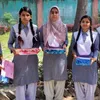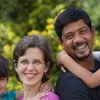This woman filmmaker is creating waves by educating tribal children in tsunami-hit Nagapattinam
R Revathi established the Vaanavil school with 20 students in 2005. This former filmmaker now educates more than 180 tribal children every year in tsunami-hit Nagapattinam.
The year 2004 witnessed the occurrence of one of the deadliest natural disasters in India’s history. The tidal waves that originated from the Indian Ocean lashed across several coastal districts of Tamil Nadu and took away the lives of more than 8,000 people. It may be a good 15 years since, but the incident still remains fresh in the minds of people.
R Revathi was 27 when she joined as a volunteer to work at a relief camp in Nagapattinam—a district in Tamil Nadu located 320 kilometres from the State capital of Chennai—one of the worst-affected coastal regions from the 2004 tsunami.
At that time, she was working as an assistant director to Tamil film director Gautham Menon, but took a sabbatical to offer her services in the disaster area. Little did she know that the experience would change her life forever.

43-year-old R Revathi.
Right at the time Revathi was wrapping up her work at Nagapattinam, she found out about the destitution of two nomadic tribal groups in the region: the Boom Boom Mattukarans, or Adiyans, who made a living by going around with decorated bulls and entertaining people, as well as the Narikuravars, who were originally hunters, but transitioned into selling beaded ornaments for everyday subsistence.
“These indigenous tribes were some of the most marginalised people I had ever met. Not only were they living without an identity or social security, but also in extreme malnourishment and poverty. While the adults were ostracised from mainstream society, the children lived in complete ignorance, without even knowing the significance behind schooling or education. I really wanted to do something to uplift their community. And, that was when I decided to set up a school,” Revathi, 43, tells SocialStory.

The Vaanavil school in Nagapattinam.
She established the Vaanavil school with 20 students in 2005.
Now, Revathi educates more than 180 children every year and is creating waves of transformation amongst the Adiyans and Narikuravars groups.
Revathi’s turning point
Revathi was born in Arakkonam, a town in the Vellore district of Tamil Nadu. She went to a government school in Saidapet, Chennai, and then went onto pursuing a degree in Mathematics from Bharati Women’s College.
However, she moved to journalism soon after, owing to her passion towards the field. So, before her directorial stint, Revathi worked with multiple media houses like Sun News, Zee News, and E Nadu TV.

Revathi with some of her students.
When Revathi stepped in as a volunteer to aid the tsunami survivors at Nagapattinam in 2004, she spotted Lakshmi, a skinny little girl milling about near a bus stand. Revathi was completely taken aback by her undernourished and skeletal look.
“For some reason, the sight of Lakshmi stayed with me. A few days later, I heard the devastating news of her death. On investigating, I found out that she belonged to the Adiyan tribe, an impoverished clan known to survive by begging on streets and doing menial jobs. They did not have an identity nor were they eligible for any governmental support. None of their children were sent to school due to lack of awareness and acceptance. My conscience did not allow me to turn away from them without offering help. At that very moment, the idea of opening a school occurred to me and I simply went ahead without giving it a second thought,” Revathi recollects.
A school for the unschooled
Revathi started off by pooling in her own personal funds amounting to Rs 25,000 to set up the school. In 2005, she began in a small sheltered room with 20 students in the heart of Keezhakarayiruppu, a village in Nagapattinam district.

A class in progress at Vaanavil school.
The school was later registered as a residential training centre under the name of Vaanavil (meaning ‘rainbow’ in Tamil), as part of the government’s Sarva Shiksha Abhiyan programme.
“The initial two years of establishing the school were not easy. I hardly had money to run the day-to-day operations. Besides, since most of the children who came to school were malnourished, I had to provide them with some wholesome food before teaching. So, I was fulfilling dual roles – that of a teacher as well as a cook,” Revathi says.
Another challenge that Revathi had to deal with was to ensure nobody drops out. Both the tribal groups used to earn their daily bread by begging. Hence, even the children who had enrolled kept wandering off into the streets in between classes to pocket some money. Many a times, Revathi had to follow them and bring the little ones back.

Students engaged in activity-based learning.
Revathi’s idea was to set up a temporary bridge school, teach the tribal children for a few months, and then help them transition into mainstream education. However, this metamorphosed into a full-fledged residential academic institution later.
“As time passed by, I realised that a bridge school would not be enough. Considering the kind of social and literacy issues that the Adiyans and Narikuravars were faced with, a long-term intervention was needed,” Revathi explains.

Tribal children being served nutritious meals at the school.
Vaanavil’s curriculum was designed on experiential learning models so that the children could indulge in some fun while acquiring knowledge. Revathi had a prior experience in educating street children as part of one of her college projects, so creating the syllabus was not difficult.
“The average age of the children who stepped into Vaanavil was anywhere between five and 11 years. All of them were illiterate, completely unaware of the notion of education. Therefore, designing a programme that would be engaging and interesting was of utmost importance. For instance, cost and selling price was taught by taking them to the vegetable market, agriculture was taught through field visits to farmlands, etc. The pedagogy also included activities like movie watching, storytelling, and performing arts,” Revathi notes.
Transforming the lives of tribal communities
It has been 15 years since Revathi instituted Vaanavil and more than 1,000 tribal children have been benefited from it.
“It is incredibly satisfying to see my efforts producing results. Back then, my goal was to enable children to understand the power of knowledge and place trust in education. Now, I think I can confidently say that I have achieved it to a certain extent,” Revathi says.

Students of Vaanavil playing kabbadi.
Today, the 43-year-old is running the residential school with batches of 80 students every year. From running the school on her own the first year to now having eight full-time teachers and 14 supporting staff, Vaanavil has come a long way.
Along the way, financial help came from crowdsourcing platforms like Milaap, individual donations, and grants from Sundaram Mutual Funds and Marc Saquet Foundation.
Revathi has also established supplemental learning centres across 10 other nearby villages spread over two districts to strengthen the education of tribal of children and get them out of begging.
On plans in the near future, she says,
“I am trying to build a livelihood project for the tribal groups with the help of the District Collector of Nagapattinam with the hope that they will get a place and identity for themselves in society and not remain invisible.”
(Edited by Evelyn Ratnakumar)









